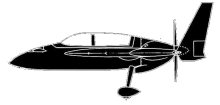
ASN Wikibase Occurrence # 353852
This information is added by users of ASN. Neither ASN nor the Flight Safety Foundation are responsible for the completeness or correctness of this information.
If you feel this information is incomplete or incorrect, you can submit corrected information.
| Date: | Wednesday 2 September 1998 |
| Time: | 09:10 LT |
| Type: |  Rutan Long-EZ |
| Owner/operator: | Private |
| Registration: | N5159P |
| MSN: | |
| Total airframe hrs: | 1450 hours |
| Engine model: | Lycoming O-235-C2C |
| Fatalities: | Fatalities: 0 / Occupants: 2 |
| Aircraft damage: | Substantial |
| Category: | Accident |
| Location: | Cascade, ID -
 United States of America United States of America
|
| Phase: | Approach |
| Nature: | Private |
| Departure airport: | (U70) |
| Investigating agency: | NTSB |
| Confidence Rating: |
The pilot, a Navy test pilot with approximately 1500 hours total flight time in the Long EZ, reported that on short final the aircraft began to settle rapidly and touched down hard approximately 250 feet short of the threshold. He indicated that there was no mechanical malfunction with the aircraft's power plant or systems. However, in his written report, he stated that on short final he 'scanned the instrument panel and noticed the airspeed read 100 mph. (This is way too high to stop a Long EZ on a 4000' runway.) Aircraft attitude seemed normal, approach was at appropriate altitude/lineup, so I reduced power and deployed the speed brake. In my aircraft, the speed brake blows closed at 95 mph from aerodynamic forces-it stayed out. As I mentally started processing the fact that the speed brake did not blow back, I sensed an increase in the rate of descent. I retracted the speed brake, added full power, and eased the nose up-touching down 250' short of the runway.' The pilot also reported that he believed the 'airspeed indicator stuck at 100 mph during final approach.' He stated that 'I'm not sure this could have reasonably been foreseen or prevented; higher approach speed would have prevented the settle that developed on short final, but I would have had to instantly recognize the airspeed indicator error. By the time I recognized an excess rate of descent and initiated a wave-off, it was too late to avoid touching down.'
Probable Cause: The pilot's failure to maintain airspeed on final approach. Factors include inadequate remedial action and erroneous airspeed indications.
Accident investigation:
 |
|
Sources:
NTSB SEA98LA173
Location
Revision history:
| Date/time | Contributor | Updates |
|---|---|---|
| 10-Mar-2024 11:20 | ASN Update Bot | Added |
Corrections or additions? ... Edit this accident description
The Aviation Safety Network is an exclusive service provided by:


 ©2024 Flight Safety Foundation
©2024 Flight Safety Foundation